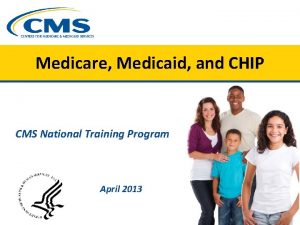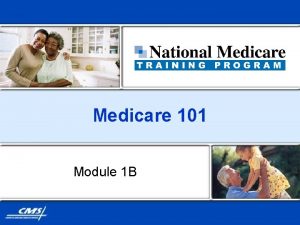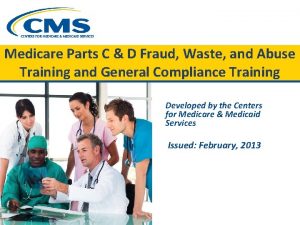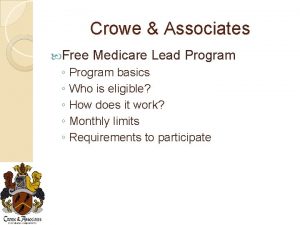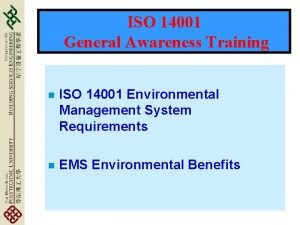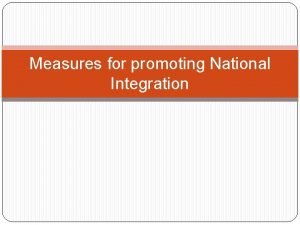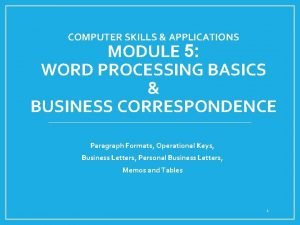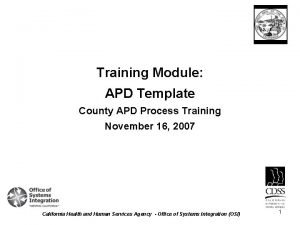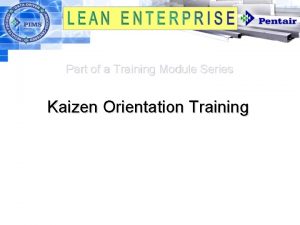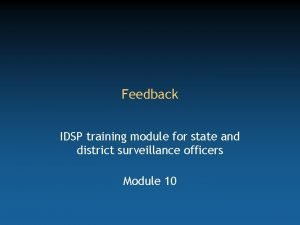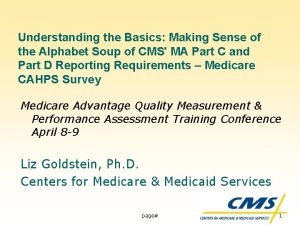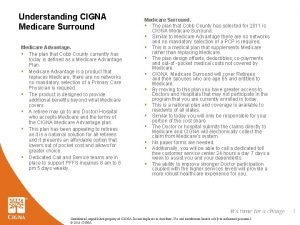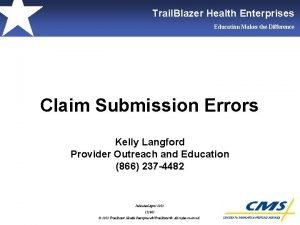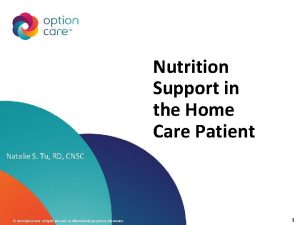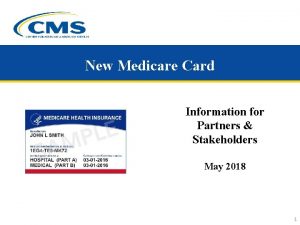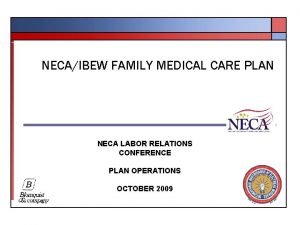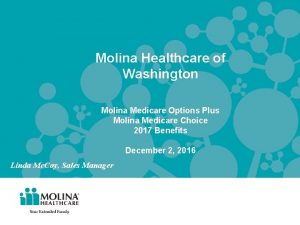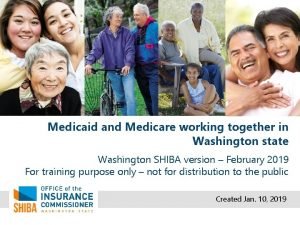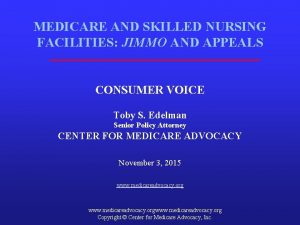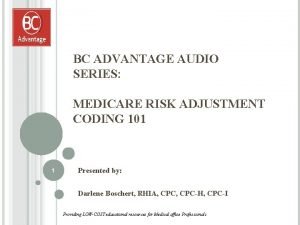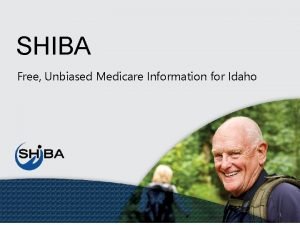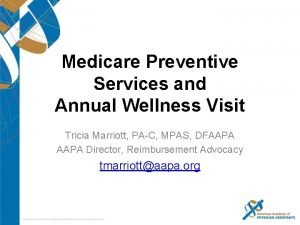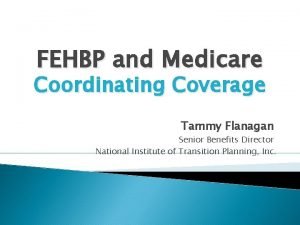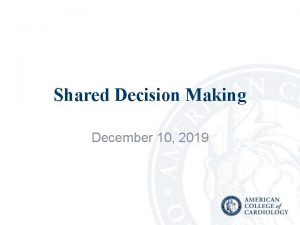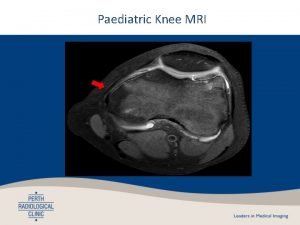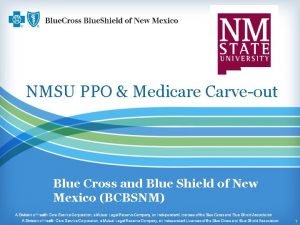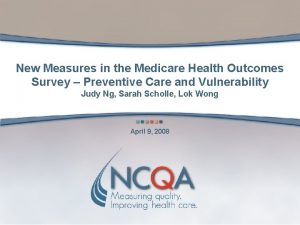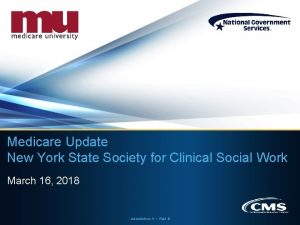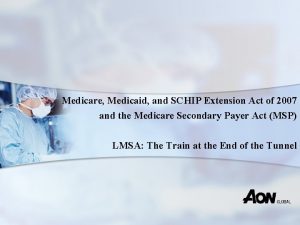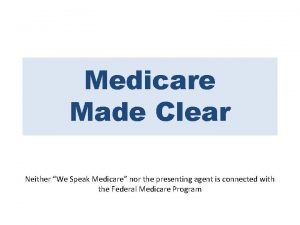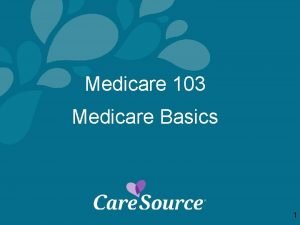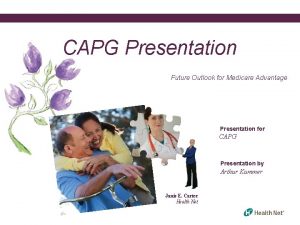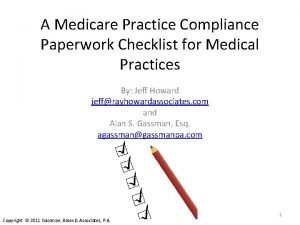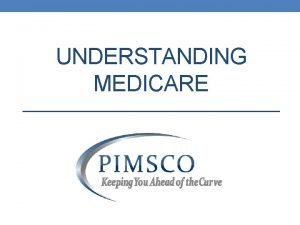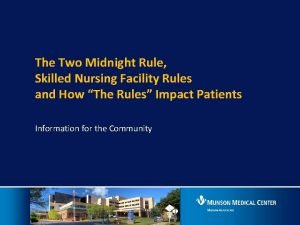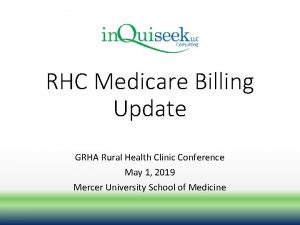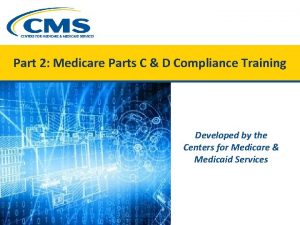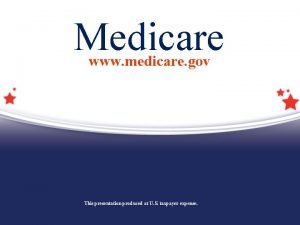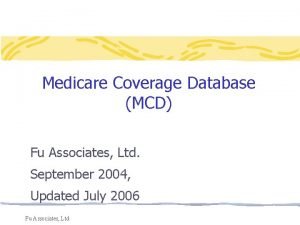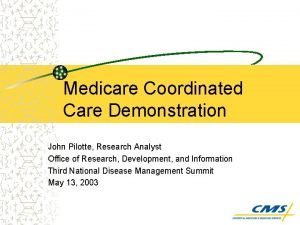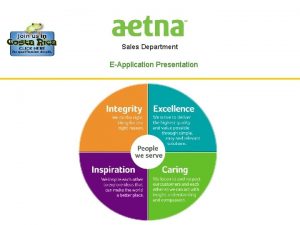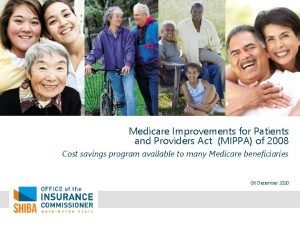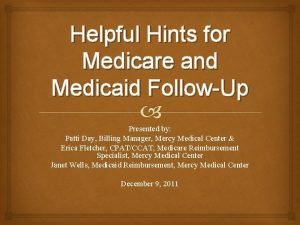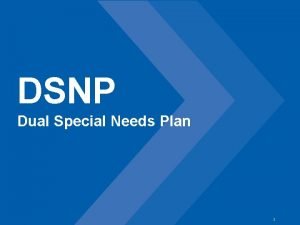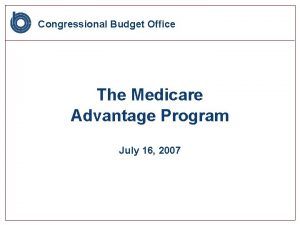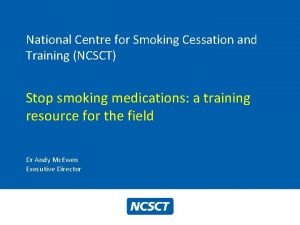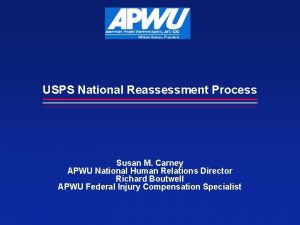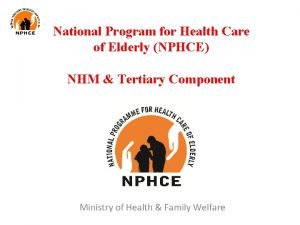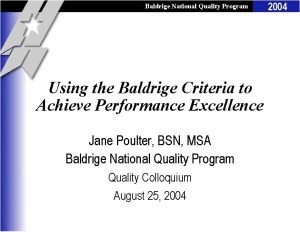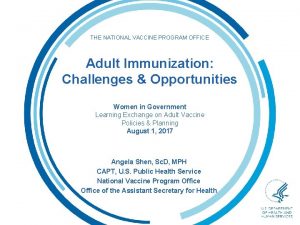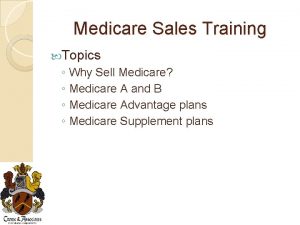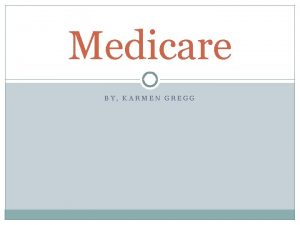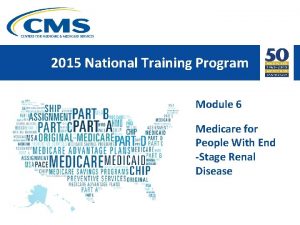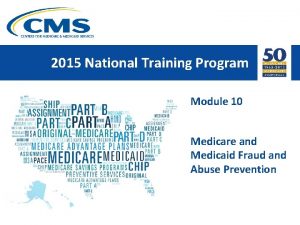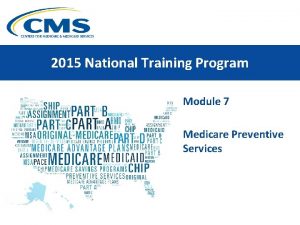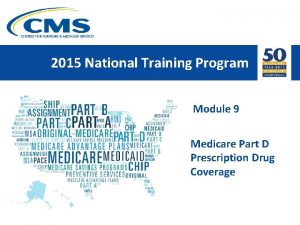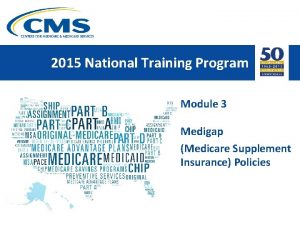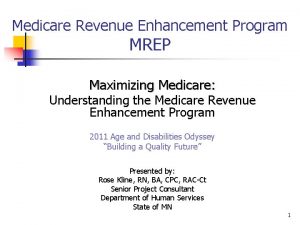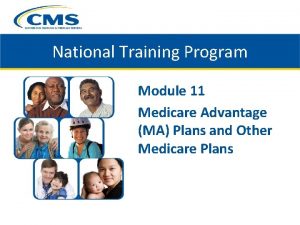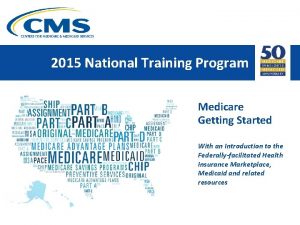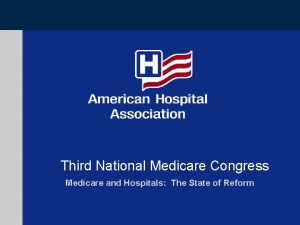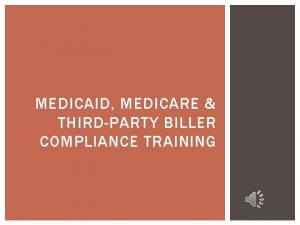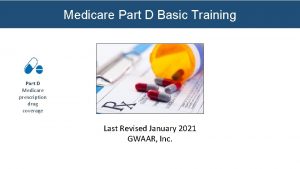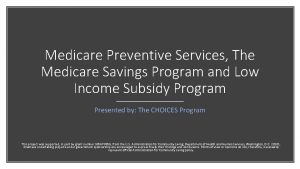2015 National Training Program Module 1 Understanding Medicare























































































































- Slides: 119

2015 National Training Program Module 1 Understanding Medicare

Session Objectives § This session should help you • • • Summarize the Medicare program Compare the parts of Medicare and coverage options Describe Medicare-covered services and supplies Recognize Medicare rights and appeals Explain programs for people with limited income and resources December 2015 Understanding Medicare

Lesson 1—Program Basics § What is Medicare? § Enrolling in Original Medicare § Part A and Part B benefits and costs December 2015 Understanding Medicare

What Is Medicare? § Health insurance for people • 65 and older • Under 65 with certain disabilities q Amyotrophic Lateral Sclerosis • Any age with End-Stage Renal Disease § Administered by • Centers for Medicare & Medicaid Services NOTE: To get Part A and/or Part B, you must be a U. S. citizen or lawfully present in the United States. December 2015 Understanding Medicare 4

The 4 Parts of Medicare December 2015 Understanding Medicare 5

Automatic Enrollment—Part A and Part B § Automatic enrollment for those receiving • Social Security benefits • Railroad Retirement Board benefits § Initial Enrollment Period Package • Mailed 3 months before q 65 or q 25 th month of disability benefits • Includes your Medicare card December 2015 Understanding Medicare 6

Medicare Card § Keep it and accept Medicare Part A and Part B § Return it to refuse Part B • Follow instructions on back of card Back Front Jane Doe December 2015 Understanding Medicare 7

When Enrolling Isn’t Automatic § If you’re not automatically enrolled • You need to enroll with Social Security q Visit socialsecurity. gov, or q Call 1 -800 -772 -1213, or q Visit your local office • If retired from the Railroad, enroll with the Railroad Retirement Board (RRB) q Call your local RRB office or 1‑ 877‑ 772‑ 5772 § Apply 3 months before you turn 65 • Don’t have to be retired to get Medicare December 2015 Understanding Medicare 8

When to Enroll in Medicare § You can first enroll during your Initial Enrollment Period (IEP), which lasts 7 months • Begins 3 months before your 65 th birthday • Includes the month you turn 65 • Ends 3 months after you turn 65 q Your start date will be delayed § Can enroll in premium-free Part A anytime after IEP begins § Can only enroll in Part B (and premium Part A) during IEP and other limited times § May have a penalty if you don't enroll during IEP December 2015 Understanding Medicare 9

General Enrollment Period (GEP) § For people who didn’t sign up for Part B (or premium Part A) during the Initial Enrollment Period § January 1–March 31 annually • Coverage starts July 1 § May have to pay a penalty • 10% for twice the number of years you didn’t have Part A • 10% for each 12 months eligible but not enrolled in Part B q As long as you have Part B December 2015 Understanding Medicare 10

Premium Part A and Part B Special Enrollment Period (SEP) § Most people don't qualify for an SEP § Must have employer group health plan (EGHP) coverage based on active, current employment of you or your spouse § Can enroll • Anytime still covered by EGHP, or • Within 8 months of the loss of coverage or current employment, whichever happens first NOTE: Retiree and COBRA coverage isn’t considered active employment. December 2015 Understanding Medicare 11

When Employer or Union Coverage Ends § When your employment ends • You may get a chance to elect Consolidated Omnibus Budget Reconciliation Act (COBRA) • You may get a Special Enrollment Period q Sign up for Part B without a penalty § Medigap Open Enrollment Period • Starts when you are both 65 and signed up for Part B • Once started, it can’t be delayed or repeated • 6 -month period December 2015 Understanding Medicare 12

Medicare Part A—Hospital Insurance Coverage § Part A–Hospital Insurance helps cover • • • Inpatient hospital care Inpatient skilled nursing facility (SNF) care Blood (inpatient) Home health care Hospice care December 2015 Understanding Medicare 13

Paying for Medicare Part A § Most people don’t pay a premium for Part A • If you paid Federal Insurance Contributions Act (FICA) taxes at least 10 years § If you paid FICA less than 10 years • Can pay a premium to get Part A § May have a penalty if you don’t enroll when first eligible for premium Part A • Your monthly premium may go up 10% • You'll have to pay the higher premium for twice the number of years you could’ve had Part A, but didn't sign up December 2015 Understanding Medicare 14

Inpatient Hospital Care Semi-private rooms Meals General nursing care Drugs that are part of your inpatient treatment § Hospital services and supplies § § December 2015 Understanding Medicare 15

Benefit Periods § Measures use of inpatient hospital and skilled nursing facility (SNF) services § Begins the day you first receive inpatient care • In hospital or SNF § Ends when not in hospital/SNF 60 days in a row § Pay Part A deductible for each benefit period • $1, 288 in 2016 § No limit to the number of benefit periods you can have December 2015 Understanding Medicare 16

Paying for Inpatient Hospital Stays For Each Benefit Period in 2016 You Pay Days 1 -60 $1, 288 deductible Days 61 -90 $322 per day Days 91 -150 $644 per day (60 lifetime reserve days) All days after 150 December 2015 All Costs Understanding Medicare 17

Skilled Nursing Facility Covered Services § § § § Semi-private room Meals Skilled nursing care Physical, occupational, and speech-language therapy Medical social services Medications, medical supplies/equipment Ambulance transportation (limited) Dietary counseling December 2015 Understanding Medicare 18

Skilled Nursing Facility (SNF) Care Required Conditions § Require daily skilled services • Not just long-term or custodial care § Hospital inpatient 3 consecutive days or longer § Admitted to SNF within specific time frame • Generally 30 days after leaving hospital § SNF care must be for a hospital-treated condition • Or condition that arose while receiving care in the SNF for hospital-treated condition § Must be a Medicare-participating SNF December 2015 Understanding Medicare 19

Paying for Skilled Nursing Facility Care For Each Benefit Period in 2016 You Pay Days 1 -20 $0 Days 21 -100 $161 per day All days after 100 December 2015 All Costs Understanding Medicare 20

Five Conditions for Home Health Care 1. Must be homebound 2. Must need skilled care on part-time or intermittent basis 3. Must be under the care of a doctor • Receiving services under a plan of care 4. Have face-to-face encounter with doctor • Prior to start of care or within 30 days 5. Home health agency must be Medicareapproved December 2015 Understanding Medicare 21

Paying for Home Health Care § Fully covered by Medicare § Plan of care reviewed every 60 days • Called episode of care § In Original Medicare you pay • Nothing for covered home health care services • 20% of Medicare-approved amount q For durable medical equipment o Covered by Part B December 2015 Understanding Medicare 22

Part A Hospice Care § Special interdisciplinary team care for the terminally ill and family • Life expectancy of 6 months or less § You must sign an election statement choosing hospice care instead of routine Medicare-covered benefits to treat your terminal illness § Focus on comfort and pain relief, not cure § Doctor must certify each “election period” • Two 90 -day periods • Then unlimited 60 -day periods • Face-to-face encounter § Hospice provider must be Medicare-approved December 2015 Understanding Medicare 23

Covered Hospice Services Physician and nursing services Physical, occupational, and speech therapy Medical equipment and supplies Drugs for symptom control and pain relief Short-term hospital inpatient care for pain and symptom management § Respite care in a Medicare-certified facility § § § • Up to 5 days each time, no limit to times § Hospice aide and homemaker services § Social worker services § Grief, dietary, and other counseling December 2015 Understanding Medicare 24

Paying for Hospice Care § In Original Medicare you pay • Nothing for hospice care • Up to $5 per Rx to manage pain and symptoms q While at home • 5% for inpatient respite care § Room and board may be covered in certain cases • Short-term respite care • For pain/symptom management that can’t be managed at home • If you have Medicaid and live in nursing facility December 2015 Understanding Medicare 25

Medicare Part B—Medical Insurance Coverage § Part B—Medical Insurance helps cover • • • Doctors’ services Outpatient medical and surgical services, supplies Clinical lab tests Durable medical equipment Diabetic testing supplies Preventive services December 2015 Understanding Medicare 26

What are Medicare Part B-Covered Services? Doctors’ Services that are medically necessary (includes outpatient and some doctor services you get when you’re a hospital inpatient) or covered preventive services. You pay 20% of the Medicare-approved amount (if the doctor accepts assignment) and the Part B deductible applies. Outpatient For approved procedures like X-rays, casts, or stitches. Medical and You pay the doctor 20% of the Medicare-approved Surgical amount for the doctor’s services if the doctor accepts Services and assignment. You also pay the hospital a copayment for Supplies each service. The Part B deductible applies. December 2015 Understanding Medicare 27

Medicare Part B-Covered Services (continued) Durable Medical Equipment (DME) December 2015 Items such as oxygen equipment and supplies, wheelchairs, walkers, and hospital beds for use in the home. Some items must be rented. Medicare has a program called “competitive bidding. ” You must use specific suppliers, or Medicare won’t pay for the item and you’ll likely pay full price. Includes national mail-order program for diabetic selftesting supplies, and includes 9 local programs for infusion pumps, including insulin pumps and pump supplies. Visit Medicare. gov/supplier to find Medicare-approved suppliers in your area. You pay 20% of the Medicare-approved amount, and the Part B deductible applies. Understanding Medicare 28

More Medicare Part B-Covered Services Home Health Services Medically necessary part-time or intermittent skilled nursing care, and/or physical therapy, speech-language pathology services, and/or services for people with a continuing need for occupational therapy, some health aide services, medical social services, and medical supplies. You pay nothing for covered services. Other Medically necessary medical services and (including but supplies, such as clinical laboratory services, not limited to) diabetes supplies, kidney dialysis services and supplies, mental health care, limited outpatient prescription drugs, diagnostic X-rays, MRIs, CT scans, and EKGs, transplants and other services are covered. Costs vary. December 2015 Understanding Medicare 29

Medicare Part B–Covered Preventive Services § "Welcome to Medicare" preventive visit § Depression screening § Yearly “Wellness” visit § Diabetes screenings § Abdominal aortic aneurysm screening § Diabetes self-management training § Alcohol misuse screening and counseling § Flu shots (Vaccine) § Bone mass measurement § Glaucoma tests § Breast cancer screening (mammogram) § Hepatitis B shots (Vaccine) § Cardiovascular disease (CVD) Risk Reduction § Visit § Hepatitis C screening test § Cardiovascular disease screenings § § Cervical and vaginal cancer screening Lung Cancer Screening § § Colorectal cancer screenings Medical nutrition therapy services § Obesity screening and counseling HIV screening • Screening fecal occult blood test § • Screening flexible sigmoidoscopy Pneumococcal shots § • Screening colonoscopy Prostate cancer screening § • Screening barium enema Sexually-transmitted infections screening and counseling • Multi-target stool DNA test § Tobacco use cessation counseling December 2015 Understanding Medicare UPDATE 30

Paying for Preventive Services § In Original Medicare you • Pay nothing for most preventive services if your provider accepts “assignment” • May pay more if provider doesn’t accept assignment • May have a copayment q If doctor performs other services not part of covered preventive benefits, or q For certain preventive services December 2015 Understanding Medicare 31

NOT Covered By Part A and Part B § § § § Long-term care Routine dental care Dentures Cosmetic surgery Acupuncture Hearing aids and exams for fitting hearing aids Other – check Medicare. gov December 2015 Understanding Medicare 32

Medicare Part B Costs for Most People Yearly Deductible $166. 00 Coinsurance § 20% coinsurance for most covered for Part B services, like doctor’s services and Services some preventive services, if provider accepts assignment § $0 for some preventive services § 20% coinsurance for outpatient mental health services, and copayments for hospital outpatient services December 2015 Understanding Medicare 33

What You Pay – Part B Premium § Most people will continue to $104. 90 per month due to no 2016 Social Security cost-of-living adjustment (if their Part B premium was deducted from their December 2015 and January 2016 Social Security or Railroad Retirement benefits [they are held harmless]) • You may pay a higher premium if you have a Part B late enrollment penalty § There is a new standard premium some people will need to pay in 2016 (see next slide) December 2015 Medicare Getting Started 34

What You Pay – 2016 Standard Part B Premium § Those who’ll pay the 2016 standard premium ($121. 80 or higher) include those in any of these 5 groups. Those who 1. 2. 3. 4. Enroll in Part B for the first time in 2016 Don’t get Social Security/Railroad Retirement benefits Are directly billed for their Part B Premiums Have both Medicare and Medicaid, and Medicaid pays their premiums 5. Have a modified adjusted gross income, as reported on their IRS tax return from 2 years ago, is above a certain amount (Income-Related Monthly Adjustment Amount [IRMAA])(see next slide) December 2015 Medicare Getting Started 35

Monthly Part B Standard Premium – Income-Related Medicare Adjustment Amount for 2016 If your yearly income in 2014 (for what you pay in 2016) was File Individual Tax File Joint Tax File Married & In 2016 Return Separate Tax You Pay Return $85, 000 or less $170, 000 or less $85, 000 or less $121. 80 $85, 000. 01–$107, 000 $170, 000. 01–$214, 000 Not applicable $170. 50 $107, 000. 01–$160, 000 $214, 000. 01–$320, 000 Not applicable $243. 60 $160, 000. 01–$214, 000 $320, 000. 01–$428, 000 $316. 70 Above $214, 000 Above $428, 000 Above $85, 00 and up to $129, 000 Above $129, 000 $389. 80 NOTE: You may pay more if you have a Part B late enrollment penalty. December 2015 Understanding Medicare 36

Paying the Part B Premium § Usually deducted monthly from • Social Security benefit payments • Railroad retirement benefit payments • Federal retirement benefit payments § If not deducted • Billed every 3 months • Medicare Easy Pay to deduct from bank account § Contact Social Security, the Railroad Retirement Board, or Office of Personnel Management about premiums December 2015 Understanding Medicare 37

Part B Late Enrollment Penalty § See how your insurance works with Medicare • Contact your employer/union benefits administrator § Penalty for not signing up when first eligible • 10% more for each full 12 -month period • May have a penalty as long as you have Part B § Sign up during a Special Enrollment Period • Usually no penalty if you sign up within 8 months of employer coverage ending December 2015 Understanding Medicare 38

Part B Late Enrollment Penalty Example Mary delayed signing up for Part B 2 full years after she was eligible. She’ll pay a 10% penalty for each full 12 month period she delayed. The penalty is added to the Part B monthly premium ($121. 80 in 2016). For 2016, her premium will be calculated as follows: $121. 80 + $ 24. 36 $146. 16 $146. 20 December 2015 (2016 Part B standard premium) (20 % of $121. 80 [2 X 10%]) (Round up) (Mary’s Part B monthly premium for 2016) Understanding Medicare 39

When You Must Have Part B § § If you want to buy a Medigap policy If you want to join a Medicare Advantage Plan You're eligible for TFL or CHAMPVA Your employer coverage requires you have it (less than 20 employees) • Talk to your employer’s or union benefits administrator § Veterans Affairs (VA) benefits are separate from Medicare • You pay a penalty if you sign up late or if you don’t sign up during your Initial Enrollment Period December 2015 Understanding Medicare 40

Check Your Knowledge—Question 1 The Part B premium most people with Medicare will pay in 2016 is $104. 90. a. True b. False December 2015 Understanding Medicare 41

Check Your Knowledge—Question 2 Medicare uses a “benefit period” to measure your use of which of the following services? a. Inpatient hospital b. Inpatient skilled nursing facility c. Home health episodes d. All of the above e. a and b December 2015 Understanding Medicare 42

Lesson 2—Medicare Coverage Choices § Your Medicare Coverage Choices § Original Medicare (Part A and Part B) • Assignment • Private Contracts § Medigap (Medicare Supplement Insurance) Policies § Medicare Prescription Drug Coverage (Part D) § Medicare Advantage Plans (Part C) § Other Medicare Health Plans December 2015 Understanding Medicare

Medicare Coverage Choices Original Medicare Part A Hospital Insurance or Medicare Advantage Plan Part C Combines Part A and Part B Medical Insurance May include, or you may be able to add You can add (Medigap) Medicare Supplement Insurance Policy December 2015 Part D Prescription Drug Coverage Understanding Medicare Part D Prescription Drug Coverage (Most Part C plans cover prescription drugs. You may be able to add drug coverage to some plan types if not already included. ) 44

Original Medicare § Health care option run by the federal government § Provides your Part A and/or Part B coverage § See any doctor or hospital that accepts Medicare § You pay • Part B premium (Part A is usually premium free) • Deductibles, coinsurance, or copayments § Get Medicare Summary Notice § Can join a Part D plan to add drug coverage December 2015 Understanding Medicare 45

Assignment § Doctor, provider, supplier accepts assignment • Signed an agreement with Medicare q Or is required by law • Accept the Medicare-approved amount q As full payment for covered services q Only charge Medicare deductible/coinsurance amount § Most accept assignment • They submit your claim to Medicare directly December 2015 Understanding Medicare 46

Not Accepting Assignment § Providers and suppliers that don’t accept assignment • May charge you more q The limiting charge is 15% more q May have to pay entire charge at time of service § Providers sometimes must accept assignment • Medicare Part B–covered prescription drugs • Ambulance suppliers December 2015 Understanding Medicare 47

Private Contracts § Agreement between you and your doctor • • Doctor doesn’t furnish services through Medicare Original Medicare and Medigap won’t pay Other Medicare plans won’t pay You’ll pay full amount for the services you get No claim should be submitted Can’t be asked to sign in an emergency The doctor can’t bill Medicare for 2 years for any services provided to anyone with Medicare December 2015 Understanding Medicare 48

Medicare Supplement Insurance § Medigap policies • Are private health insurance • Supplement Original Medicare q You must have both Medicare Part A and Part B to get a Medigap policy • Help pay some health care costs that Original Medicare doesn’t cover (coverage “gaps”) q Medicare will pay its share of the Medicareapproved amounts for covered health care costs o Then your Medigap policy pays its share q A Medigap policy covers one person December 2015 Understanding Medicare 49

Medigap Plans § Standardized plans identified by a letter • Plans A, B, C, D, F, G, K, L, M, and N are currently sold • Companies don’t have to sell all plans • Plans E, H, I, and J exist but are no longer sold • Plans with the same letter must offer the same basic benefits q Only the policy cost will vary between companies § Waiver states (Massachusetts, Minnesota, and Wisconsin) standardize in a different way December 2015 Understanding Medicare 50

Medigap Policies § § You pay a monthly premium Costs vary by plan, company, your age, and location Follow federal/state laws that protect you Medigap Open Enrollment Period • Starts when you are both 65 and signed up for Part B • Once started, it can’t be delayed or repeated § Doesn’t work with Medicare Advantage § No networks except with a Medicare SELECT policy December 2015 Understanding Medicare 51

Delayed Medigap Open Enrollment Period (OEP) § If you delay enrolling in Medicare Part B • Because you or your spouse is still working, and • You have group health coverage § Medigap OEP is delayed • Until you’re 65 and enrolled in Part B • No late enrollment penalty § Notify Social Security to delay Part B December 2015 Understanding Medicare 52

Pre-Existing Conditions and Medigap § Health problem you had before the new insurance policy starts • Treated or diagnosed 6 months before coverage start date § Pre-Existing Condition Waiting Period • Insurance companies can refuse to cover out-of-pocket costs for excluded condition for up to 6 months (“look-back period”) q Without 6 months of prior creditable coverage and no break in coverage more than 63 days The Affordable Care Act doesn’t impact the pre-existing condition waiting period for Medigap coverage. December 2015 Understanding Medicare 53

Medigap for People With a Disability or End-Stage Renal Disease (ESRD) § People with a disability or ESRD may not be able to buy a policy until they turn 65 • Some states require insurers to sell Medigap policies to people with a disability or ESRD § Companies may voluntarily sell Medigap policies • May cost more than policies sold to people over 65 • Can use medical underwriting § Get a Medigap Open Enrollment Period at 65 December 2015 Understanding Medicare 54

Right to Suspend Medigap for People With Medicaid § If you have both Medicare and Medicaid • You generally can’t buy a Medigap policy § You can suspend your Medigap policy • Within 90 days of getting Medicaid q For up to 2 years § You can start it up again • No new medical underwriting or waiting periods December 2015 Understanding Medicare 55

Check Your Knowledge—Question 3 Medigap policies work with which of the following? a. Original Medicare b. Medicare Advantage Plans c. Medicaid d. Medicare Prescription Drug Plans December 2015 Understanding Medicare 56

Medicare Prescription Drug Coverage (Part D) § § § § What Is Part D? Medicare Prescription Drug Plans Medicare Drug Plan Costs Standard Structure Improved Coverage in the Coverage Gap Eligibility Requirements When to Join and Switch Plans Part D–covered Drugs • Drugs Not Covered § How Plans Manage Access To Covered Drugs § Requirements for Prescribers December 2015 Understanding Medicare 57

What Is Part D (Medicare Prescription Drug Coverage)? § Medicare drug plans • Approved by Medicare • Run by private companies • Available to everyone with Medicare § You must join a plan to get coverage § There are 2 ways to get coverage 1. Medicare Prescription Drug Plans 2. Medicare Health Plans with prescription drug coverage December 2015 Understanding Medicare 58

Medicare Prescription Drug Plans § Can be flexible in benefit design § Must offer at least a standard level of coverage § Vary in costs and drugs covered • Different tier and/or copayment levels • Deductible • Coverage for drugs not typically covered by Part D § Benefits and costs may change each year December 2015 Understanding Medicare 59

Medicare Prescription Drug Plan Costs § Costs vary by plan § In 2016, most people will pay A monthly premium A yearly deductible (if applicable) Copayments or coinsurance 45% for covered brand-name drugs in the coverage gap • 58% for covered generic drugs in the coverage gap • Very little after spending $4, 850 out of pocket • • December 2015 Understanding Medicare 60

Part D Eligibility Requirements § You must have Medicare Part A and/or Part B to join a Medicare Prescription Drug Plan § You must have Medicare Part A and Part B to join a Medicare Advantage Plan with drug coverage § You must have Medicare Part A and Part B or only Part B to join a Medicare cost plan with Part D coverage § You must live in the plan’s service area • You can’t be incarcerated • You can’t be unlawfully present in the United States • You can’t live outside the United States Effective 1/1/2016 § You must join a plan to get drug coverage December 2015 Understanding Medicare 61

Part D Initial Enrollment Period (IEP) § When you first become eligible to get Medicare • 7 -month IEP for Part D If You Join Coverage Begins During the 3 months before you Date eligible for Medicare turn 65 During the month you turn 65 First day of the following month During the 3 months after you turn 65 First day of the month after month you apply December 2015 Understanding Medicare 62

When You Can Join or Switch Plans § Medicare’s Open Enrollment Period is October 15– December 7 each year, coverage starts January 1 § You can leave a Medicare Advantage Plan and switch to Original Medicare from January 1–February 14 each year • You have until February 14 to also join a Part D plan § If you don’t have Medicare Part A coverage, and enroll in Part B during the General Enrollment Period (January 1–March 31), you can sign up for a Medicare Prescription Drug Plan from April 1–June 30 each year December 2015 Understanding Medicare 63

Special Enrollment Period (SEP) § Life events that allow an SEP include • You permanently move out of your plan’s service area • You lose other creditable prescription coverage • You weren’t properly told that your other coverage wasn’t creditable, or your other coverage was reduced and is no longer creditable • You enter, live at, or leave a long-term care facility • You have a continuous SEP if you qualify for Extra Help • You belong to a State Pharmaceutical Assistance Program • You join or switch to a plan that has a 5 -star rating • Other exceptional circumstances December 2015 Understanding Medicare 64

5 -Star Special Enrollment Period (SEP) § Use the Medicare Plan Finder tool at Medicare. gov to see quality and performance ratings § Star ratings are given once a year, assigned in October of the past year § Use 5 -star SEP to switch to any 5 -star plan one time • December 8–November 30 of following year • Coverage starts first day of month after enrolled • Be careful not to switch from a Medicare Advantage (MA) Plan with drug coverage to an MA Plan with no Part D coverage December 2015 Understanding Medicare 65

Part D Late Enrollment Penalty § Higher premium if you wait to enroll • Exceptions if you have q Creditable coverage q Extra Help § Pay penalty for as long as you have coverage • 1% of base beneficiary premium ($34. 10 in 2016) q For each full month eligible and not enrolled • Amount changes every year December 2015 Understanding Medicare 66

Income-Related Monthly Adjustment Amount (IRMAA) Your Yearly Income in In 2016 You Pay Monthly in 2014 Filing a Joint Tax Individual Tax Return $85, 000 or less $170, 000 or less Your Plan Premium (YPP) Above $85, 000 Up to $107, 000 Above $107, 000 Up to $160, 000 Above $160, 000 Up to $214, 000 Above $170, 000 Up to $214, 000 Above $214, 000 Up to $320, 000 Above $320, 000 Up to $428, 000 Above $428, 000 YPP + $12. 70* YPP + $32. 80* YPP + $52. 80* YPP + $72. 90* IRMAA is adjusted each year, as it’s calculated from the annual beneficiary base premium. December 2015 Understanding Medicare 67

Standard Structure in 2016 Ms. Smith joins a prescription drug plan. Her coverage begins on January 1, 2016. She doesn’t get Extra Help and uses her Medicare drug plan membership card when she buys prescriptions. She pays a monthly premium throughout the year. 1. Yearly 2. Copayment or deductible coinsurance (what you pay at the pharmacy) 3. Coverage gap 4. Catastrophic coverage Ms. Smith pays the first $360 of her drug costs before her plan starts to pay its share. Once Ms. Smith and her plan have spent $3, 310 for covered drugs, she’s in the coverage gap. In 2016, she pays 45% of the plan’s cost for her covered brand-name prescription drugs and 58% of the plan’s cost for covered generic drugs. What she pays (and the discount paid by the drug company) counts as out-of-pocket spending, and helps her get out of the coverage gap. Once Ms. Smith has spent $4, 850 out of pocket for the year, her coverage gap ends. Now she only pays a small coinsurance or copayment for each covered drug until the end of the year. December 2015 Ms. Smith pays a copayment, and her plan pays its share for each covered drug until their combined amount (plus the deductible) reaches $3, 310. Understanding Medicare 68

Improved Coverage in the Coverage Gap Year What You Pay for Covered Brand-Name Drugs in the Coverage Gap 2015 2016 2017 2018 2019 2020 December 2015 45% 40% 35% 30% 25% What You Pay for Covered Generic Drugs in the Coverage Gap 65% 58% 51% 44% 37% 25% Understanding Medicare 69

Part D–Covered Drugs § Prescription brand-name and generic drugs • Approved by the U. S. Food and Drug Administration • Used and sold in United States • Used for medically accepted indications § Includes drugs, biological products, and insulin • And supplies associated with injection of insulin § Plans must cover a range of drugs in each category § Coverage and rules vary by plan December 2015 Understanding Medicare 70

Required Coverage § All drugs in 6 protected categories 1. 2. 3. 4. 5. 6. Cancer medications HIV/AIDS treatments Antidepressants Antipsychotic medications Anticonvulsive treatments Immunosuppressants § All commercially available vaccines • Except those covered under Part B (e. g. , flu shot) December 2015 Understanding Medicare 71

Requirement for Prescribers § Enforcement date January 1, 2016 § Prescribers of Part D drugs must • Be enrolled in an approved status, or • Have a valid opt-out affidavit on file for their prescriptions to be covered under Part D December 2015 Understanding Medicare 72

Drugs Excluded by Law Under Part D § Drugs for anorexia, weight loss, or weight gain § Erectile dysfunction drugs when used for the treatment of sexual or erectile dysfunction § Fertility drugs § Drugs for cosmetic or lifestyle purposes § Drugs for symptomatic relief of coughs and colds § Prescription vitamin and mineral products § Non-prescription drugs December 2015 Understanding Medicare 73

How Plans Manage Access to Drugs Prior Authorization § Doctor must contact plan for prior approval and show medical necessity for drug before drug will be covered Step Therapy § Must first try similar, less expensive drug § Doctor may request an exception if • Similar, less expensive drug didn’t work, or • Step therapy drug is medically necessary Quantity Limits § Plan may limit drug quantities over a period of time for safety and/or cost § Doctor may request an exception if additional amount is medically necessary December 2015 Understanding Medicare 74

Formulary § A list of prescription drugs covered by the plan § May have tiers that cost different amounts Tier Structure Example December 2015 Understanding Medicare 75

Check Your Knowledge—Question 4 The Part D late enrollment penalty lasts for a. 12 months b. 2 years c. As long as you have coverage d. 36 months December 2015 Understanding Medicare 76

Compare Plans on Medicare Plan Finder § Search for drug and health plans § Personalize your search to find plans that meet your needs § Compare plans based on star ratings, benefits, costs, and more § Visit Medicare. gov/finda-plan/ questions/ home. aspx December 2015 Understanding Medicare 77

Medicare Advantage (MA) Plans (Part C) § § § What they are How the plans work MA Plan costs Who can join When to join and switch plans Other Medicare health plans December 2015 Understanding Medicare 78

What is a Medicare Advantage Plan? § Health plan options • Approved by Medicare • Run by private companies § § Part of the Medicare program Sometimes called Part C Available across the country Provide Medicare-covered benefits • May cover extra benefits December 2015 Understanding Medicare 79

How Medicare Advantage Plans Work § Receive services through the plan • All Part A– and Part B–covered services • Some plans may provide additional benefits § Most plans include prescription drug coverage § You may have to use network doctors/hospitals § May differ from Original Medicare • Benefits • Cost-sharing December 2015 Understanding Medicare 80

How Medicare Advantage (MA) Plans Work (Continued) § You’re still in the Medicare program • Medicare pays the plan every month for your care § You still have Medicare rights and protections § If the plan leaves Medicare you can • Join another MA Plan, or • Return to Original Medicare December 2015 Understanding Medicare 81

Medicare Advantage Costs § You still pay the Part B premium • A few plans may pay all or part for you • State assistance for some § You may plan an additional monthly premium § You pay deductibles, coinsurance, and copayments • Different from Original Medicare • Vary from plan to plan • May be higher if out of network December 2015 Understanding Medicare 82

Who Can Join a Medicare Advantage Plan? § Eligibility requirements • Enrolled in Medicare Part A (Hospital Insurance) • Enrolled in Medicare Part B (Medical Insurance) • Live in the plan’s service area § To join you must also • Provide necessary information to the plan • Follow the plan’s rules § Can only belong to one plan at a time December 2015 Understanding Medicare 83

When You Can Join or Switch Medicare Advantage Plans Initial Enrollment Period § 7 -month period begins 3 months before the month you turn 65 § Includes the month you turn 65 § Ends 3 months after the month you turn 65 Medicare Open Enrollment Period “Open Enrollment” Medicare due to a Disability § October 15–December 7 § Coverage begins January 1 § 7 -month period begins 3 months before the 25 th month of disability. § Ends 3 months after the 25 th month of disability. § Plans must be allowing new members to join December 2015 Understanding Medicare 84

When You Can Join or Switch Plans Special Enrollment Periods (SEP) December 2015 § Move out of your plan’s service area § Plan leaves Medicare program or reduces its service area § Leaving or losing employer or union coverage § You enter, live at, or leave a long-term care facility § You have a continuous SEP if you qualify for Extra Help § Losing your Extra Help status § You join or switch to a plan that has a 5 -star rating § Retroactive notice of Medicare entitlement § Other exceptional circumstances Understanding Medicare 85

When You Can Join or Switch Medicare Advantage Plans 5 -Star Special § Can enroll in 5 -star Medicare Advantage (MA), Prescription Drug Plan (PDP), Medicare Advantage Enrollment Plan with prescription drug coverage (MA-PD), or Period (SEP) Cost Plan § Enroll once yearly from December 8–November 30 § New plan starts first day of month after enrolled § Star ratings given once per year • Ratings assigned in October and effective January 1 • Use Medicare Plan Finder to see star ratings q Look at Overall Plan Rating to find eligible plans December 2015 Understanding Medicare 86

When You Can Leave Medicare Advantage Plans January 1 – § You can leave a Medicare Advantage (MA) February 14 Plan § Switch to Original Medicare • Coverage begins first day of month after switch • May join Part D Plan q Drug coverage begins first day of month after plan gets enrollment § May not join another MA Plan during this period § May be able to buy a Medigap (Medicare Supplement Insurance) policy December 2015 Understanding Medicare 87

Types of Medicare Advantage Plans § § § Health Maintenance Organization (HMO) HMO Point-of-Service Preferred Provider Organization Special Needs Plan Private Fee-for-Service Medicare Medical Savings Account December 2015 Understanding Medicare 88

Other Medicare Plans § Other types of Medicare health plans that provide health care coverage aren’t part of Medicare Advantage • But are still part of Medicare • Some provide Part A and/or Part B coverage • Some provide Medicare prescription drug coverage § Examples include Medicare Cost Plans, Innovation Projects and Pilot Programs, and Medicare Program of All-inclusive Care for the Elderly (PACE) Plans December 2015 Understanding Medicare 89

Check Your Knowledge—Question 5 Most people are no longer required to pay a monthly Medicare Part B premium while enrolled in a Medicare Advantage Plan. a. True b. False December 2015 Understanding Medicare 90

Lesson 3—Rights and the Appeals Process § Patient rights § Appeals process • Part A and Part B (Original Medicare) q Medigap Rights • Part C (Medicare Advantage) • Part D (Medicare Prescription Drug Coverage) December 2015 Understanding Medicare

Medicare Guaranteed Rights § Specific rights in 1. Original Medicare 2. Medicare Advantage and other Medicare health plans 3. Medicare Prescription Drug Plans § In general, these rights • • Protect you when you get health care Protect you against unethical practices Make sure you get medically necessary services Protect your privacy December 2015 Understanding Medicare 92

Your Medicare Rights You have the right to § Be treated with dignity and respect § Be protected from discrimination • • Race, color, or national origin Sex Age Disability § If you think you haven’t been treated fairly, visit HHS. gov/ocr • Call the Office for Civil Rights at 1 -800 -368 -1019 • TTY users should call 1 -800 -537 -7697 December 2015 Understanding Medicare 93

“Notice of Privacy Practices for Original Medicare” § Tells you how Medicare • Must protect the privacy of your personal health information • Uses and discloses your personal medical information § Describes your rights and how you can exercise them § Published annually in the “Medicare & You” handbook § For more information • Visit Medicare. gov • Call 1 -800 -MEDICARE (1 -800 -633 -4227) • TTY users should call 1 -877 -486 -2048 December 2015 Understanding Medicare 94

Who’s the Medicare Beneficiary Ombudsman? § An ombudsman is a person who reviews complaints and helps resolve them § The Medicare Beneficiary Ombudsman help make sure information is available about • Medicare coverage • Making good health care decisions • Medicare rights and protections • Getting issues resolved § The Ombudsman reviews the concerns raised by people with Medicare § The Ombudsman reports yearly to Congress December 2015 Understanding Medicare 95

Medicare Rights—Claims and Appeals You have the right to § Have a claim for payment filed with Medicare § Get decisions about • Health care payment • Coverage of services • Prescription drug coverage § Get an appeal (review) of the decisions above December 2015 Understanding Medicare 96

Medicare Grievance Rights You have the right to § File complaints (also called grievances) about • Services you got • Other concerns or problems getting health care and quality of care q q q December 2015 In Original Medicare, call the Beneficiary and Family Centered Care Quality Improvement Organization (BFCC-QIO) In Medicare Advantage or other Medicare health plan, call your plan, the BFCC-QIO, or both If you have End-Stage Renal Disease (ESRD), call the ESRD network in your state Understanding Medicare 97

Medigap Rights in Original Medicare § Buy a private Medigap (Medicare Supplement Insurance) policy • Guaranteed issue rights in your Medigap Open Enrollment Period ensure insurance companies q q Can’t deny you Medigap coverage Can’t place conditions on coverage Must cover pre-existing conditions Can’t charge more because of past or present health problems • Some states give additional rights December 2015 Understanding Medicare 98

Coverage and Appeal Rights in Medicare Health Plans You have the right to § Know how your doctors are paid § Get a coverage decision or coverage information § A fair, efficient, and timely appeals process • Five levels of appeal • Decision letter sent explaining further appeal rights • Automatic review of Part C plan reconsideration q By Independent Review Entity (IRE) § File a grievance about concerns or problems December 2015 Understanding Medicare 99

Requesting Part D Appeals § If your coverage determination or exception is denied, you can appeal the plan’s decision § In general, you must make your appeal requests in writing • Plans must accept verbal expedited (fast) requests • Limited timeframe to file an appeal request (within 60 days or later with good cause) § An appeal can be requested by • You or your appointed representative • Your doctor or other prescriber § There are 5 levels of appeals December 2015 Understanding Medicare 100

Check Your Knowledge—Question 6 An appeal is related to a. The quality of the services you received b. A coverage and/or payment decision c. A payment decision d. The health care you received December 2015 Understanding Medicare 101

Lesson 4—Programs for People With Limited Income and Resources § § § Differences between Medicare and Medicaid Children’s Health Insurance Program (CHIP) Medicare Savings Programs Extra Help available for people in the United States territories December 2015 Understanding Medicare

What Is Medicaid? § Federal-state health insurance program • For people with limited income/resources • Covers most health care costs q If you have both Medicare and Medicaid § Eligibility determined by state § Application processes and benefits vary § State office names vary • Apply if you MIGHT qualify § Children’s Health Insurance Program (CHIP) • Covers uninsured children up to age 19 and may cover pregnant women when q Family income too high for Medicaid December 2015 Understanding Medicare 103

Medicare Savings Programs § Help from Medicaid paying Medicare costs • For people with limited income and resources § Often higher income and resources than full Medicaid § Programs include • • Qualified Medicare Beneficiary (QMB) Specified Low-income Medicare Beneficiary (SLMB) Qualifying Individual (QI) Qualified Disabled & Working Individuals (QDWI) December 2015 Understanding Medicare 104

What Is Extra Help? § Program to help people pay for Medicare prescription drug costs (Part D) • Also called the low-income subsidy § If you have lowest income and resources • Pay no premiums or deductible, and small or no copayments § If you have slightly higher income and resources • Pay reduced deductible and a little more out of pocket § No coverage gap or late enrollment penalty if you qualify for Extra Help December 2015 Understanding Medicare 105

Qualifying for Extra Help § You automatically qualify for Extra Help if you get • Full Medicaid coverage • Supplemental Security Income (SSI) • Help from Medicaid paying your Medicare premiums § All others must apply • Online at socialsecurity. gov • Call Social Security at 1 -800 -772 -1213 (TTY 1 -800 -3250778) q Ask for “Application for Help with Medicare Prescription Drug Plan Costs” (SSA-1020) • Contact your state Medicaid agency December 2015 Understanding Medicare 106

Steps to Take § If you think you might qualify for any of these programs 1. Review the income and asset guidelines 2. Collect your personal documents 3. Get more information • Call your state Medical Assistance office • Call your local State Health Insurance Assistance Program • Call your local Area Agency on Aging 4. Complete application with state Medical Assistance office December 2015 Understanding Medicare 107

Programs in U. S. Territories § Help people pay their Medicare costs § U. S. territories • • • Puerto Rico Virgin Islands Guam Northern Mariana Islands American Samoa § Programs vary • Contact Medical Assistance office December 2015 Understanding Medicare 108

Check Your Knowledge—Question 7 Medicare Savings Programs frequently have higher income and resource limits than Medicaid. a. True b. False December 2015 Understanding Medicare 109

Lesson 5—Medicare and the Health Insurance Marketplace § Marketplace and People with Medicare § Marketplace and Becoming Eligible for Medicare § Enrollment Considerations December 2015 Understanding Medicare

Marketplace and People With Medicare § Medicare isn’t part of the Marketplace § If you have Medicare you don’t need to do anything related to the Marketplace • Your benefits don’t change because of the Marketplace • No one can sell you a Marketplace plan q Even if you have only Medicare Part A and/or Part B q Except an employer through the Small Business Health Options Program (SHOP) if you’re an active worker or dependent of an active worker o o The SHOP employer coverage may pay first No late enrollment penalty if you delay Medicare § Doesn’t include COBRA coverage § The Marketplace doesn’t offer Medigap or Part D plans December 2015 Understanding Medicare 111

Marketplace and Becoming Eligible for Medicare § You can keep a Marketplace plan after your Medicare coverage begins • You may cancel the plan when Medicare coverage starts, or • Once your Part A coverage starts you won’t be able to get lower costs for your Marketplace plan § Sign up for Medicare during your Initial Enrollment Period • Or, if you enroll later, you may have to pay a late enrollment penalty for as long as you have Medicare • The Individual Marketplace isn't employer-sponsored coverage q You won't be able to enroll in Part B later using the Special Enrollment Period December 2015 Understanding Medicare 112

If You Have a Marketplace Plan First and Then Get Medicare Coverage § You lose eligibility for any premium tax credits and/or reduced cost sharing for your Marketplace plan § If you choose to drop your Marketplace plan, wait until you’re covered by Medicare to avoid a gap in coverage • Depending on your income and resources, you may be eligible for help paying your Medicare Part B and Part D premiums and for some reduced cost sharing for Medicare Part D coinsurance/copayments • You may also be able to buy a Medigap (Medicare Supplement Insurance) policy or join a Medicare Advantage Plan (like a Health Maintenance Organization (HMO) or Preferred Provider Organization (PPO)) December 2015 Understanding Medicare 113

Choosing Marketplace Instead of Medicare § The Individual Marketplace isn't employer-sponsored coverage § You can’t choose Marketplace coverage instead of Medicare unless 1. You pay or you’d have to pay a Part A premium q You can drop Part A and Part B and may be eligible to get a Marketplace plan 2. You have a medical condition that qualifies you for Medicare (like ESRD) but haven’t applied for Medicare 3. You’re not yet collecting Social Security retirement or disability benefits before you’re eligible for Medicare December 2015 Understanding Medicare 114

Medicare for People With Disabilities and the Marketplace § You may qualify for Medicare based on a disability • You must be entitled to Social Security Disability Insurance (SSDI) benefits for 24 months th month, you’re automatically enrolled in q On the 25 Medicare Part A and Part B § If you’re getting SSDI, you can get a Marketplace plan to cover you during your 24 -month waiting period • You may qualify for premium tax credits and reduced cost-sharing until your Medicare coverage starts December 2015 Understanding Medicare 115

Marketplace/Medicare Enrollment Considerations § If you don’t enroll in Medicare when you’re first eligible (Initial Enrollment Period) • • A late enrollment penalty may apply (lifetime) You generally can’t enroll until the Medicare General Enrollment Period (January 1 to March 31) and coverage won’t start until July 1 § If your Marketplace plan isn’t through your employer • • June 2015 And you must pay a premium for Part A, you would need to drop Part A and Part B to be eligible to get a Marketplace plan However, if you’re also receiving Social Security benefits, you would have to drop your Social Security if you drop Medicare Understanding Medicare 116

Check Your Knowledge—Question 8 You can enroll in the Individual Marketplace instead of Part B and get Part B later using a Special Enrollment Period if you don’t have coverage from current, active employment. a. True b. False December 2015 Understanding Medicare 117

Introduction to Medicare Resource Guide Resources Additional Resources Medicare Products Centers for Medicare & Medicaid Services (CMS) 1 -800 -MEDICARE (1 -800 -633 -4227) (TTY 1 -877 -486 -2048) Medicare. gov CMS. gov State Health Insurance Assistance Programs* “Medicare & You Handbook” CMS Product No. 10050 *For phone numbers, call CMS 1 -800 -MEDICARE (1 -800 -633 -4227) 1 -877 -486 -2048 for TTY users Medicare. gov/Contacts/ “Your Medicare Benefits” CMS Product No. 10116 Medicaid. gov Health. Care. gov Affordable Care Act Health. Care. gov/law/full/index. html Social Security 1‑ 800‑ 772‑ 1213 1‑ 800‑ 325‑ 0778 for TTY users Social. Security. gov/ Railroad Retirement Board 1 -877 -772 -5772 1 -312 -751 -4700 for TTY users RRB. gov/ U. S. Department of Health and Human Services, Office for Civil Rights HHS. gov/ocr/office/index. html 1 -800 -368 -1019 1 -800 -537 -7697 for TTY users Benefits. gov Insure. Kids. Now. gov December 2015 Understanding Medicare “Choosing a Medigap Policy: A Guide to Health Insurance for People with Medicare” CMS Product No. 02110 To access these products: View and order single copies at Medicare. gov/publications Order multiple copies (partners only) at productordering. cms. hhs. gov. You must register your organization.

CMS National Training Program (NTP) To view all available NTP training materials, or to subscribe to our email list, visit CMS. gov/Outreach-and-Education/Training/ CMSNational. Training. Program/index. html For questions about training products email training@cms. hhs. gov
 Medicare training program
Medicare training program D
D Medicare training 101
Medicare training 101 Downstream entity examples
Downstream entity examples Medicare part d training for pharmacies
Medicare part d training for pharmacies Humana ahip medicare training portal
Humana ahip medicare training portal Pinpoint medicare training
Pinpoint medicare training Medicare lead programs
Medicare lead programs Module 22 understanding consciousness and hypnosis
Module 22 understanding consciousness and hypnosis C device module module 1
C device module module 1 Iso 9001:2015 presentation
Iso 9001:2015 presentation Iso 9001:2015 management review meeting presentation ppt
Iso 9001:2015 management review meeting presentation ppt Iso 14001 awareness
Iso 14001 awareness National 5 pe marking scheme
National 5 pe marking scheme National 5 understanding standards
National 5 understanding standards Need of national integration
Need of national integration 7 core subjects of iso 26000
7 core subjects of iso 26000 Team building training materials
Team building training materials Sbcc training module
Sbcc training module Ccra training
Ccra training Hbyc age limit
Hbyc age limit Word processing packages
Word processing packages Module 9 computer concepts
Module 9 computer concepts Module 11 computer concepts exam
Module 11 computer concepts exam 8 step training model board questions
8 step training model board questions Training module sample
Training module sample Training module design template
Training module design template Kaizen training module
Kaizen training module Ditto amway
Ditto amway Teamwork training module
Teamwork training module Mary fertakis training module
Mary fertakis training module Gmp training topics
Gmp training topics Idsp training module
Idsp training module Medicare phonetic alphabet
Medicare phonetic alphabet What is cigna medicare surround
What is cigna medicare surround Trailblazer health enterprises
Trailblazer health enterprises Pn
Pn Us medicare card
Us medicare card Family medical care plan
Family medical care plan Molina medicare washington
Molina medicare washington Medicare vs medicaid washington state
Medicare vs medicaid washington state New medicare card poster
New medicare card poster Ivr conversion tool novitas
Ivr conversion tool novitas How to win a medicare appeal for skilled nursing
How to win a medicare appeal for skilled nursing Medicare advantage risk adjustment 101
Medicare advantage risk adjustment 101 Medicare oncology care model
Medicare oncology care model Shiba medicare idaho
Shiba medicare idaho Medicare preventive services quick reference
Medicare preventive services quick reference Tammy flanagan
Tammy flanagan Medicare advantag
Medicare advantag Medicare part d covers
Medicare part d covers Medicare assistant
Medicare assistant Seoulin medicare
Seoulin medicare 15yo
15yo Medicare carve out
Medicare carve out Medicare health outcomes survey
Medicare health outcomes survey Medicare jurisdiction k
Medicare jurisdiction k Mmsea act of 2007
Mmsea act of 2007 We speak medicare
We speak medicare Ibt for obesity
Ibt for obesity Medicare part d covers
Medicare part d covers Medicare part d covers
Medicare part d covers Medicare
Medicare Medicare future outlook
Medicare future outlook Khmer rouge apush
Khmer rouge apush Medicare compliance checklist
Medicare compliance checklist What is medicare
What is medicare What is the 2 midnight rule
What is the 2 midnight rule How with medicares rising
How with medicares rising Medicare rural health clinic billing
Medicare rural health clinic billing Medicare jeopardy game
Medicare jeopardy game Medicare parts c and d sponsors are not required
Medicare parts c and d sponsors are not required Medicare subsidy
Medicare subsidy Www medicare gov
Www medicare gov Mcd database
Mcd database Medicare coordinated care demonstration
Medicare coordinated care demonstration Medicare
Medicare Opt in simplified enrollment mechanism
Opt in simplified enrollment mechanism Medicare supplement sales presentation
Medicare supplement sales presentation Medicare improvements for patients and providers act
Medicare improvements for patients and providers act Cgs medicare credit balance report
Cgs medicare credit balance report H3387 010
H3387 010 Cigna medicare surround
Cigna medicare surround Aetna medicare advantage ppo esa shbp
Aetna medicare advantage ppo esa shbp National unification and the national state
National unification and the national state The use of uniform terminology and plain english
The use of uniform terminology and plain english National training seminar
National training seminar National tim responder training test answers
National tim responder training test answers National tim responder training test answers
National tim responder training test answers National dangerous goods training consortium
National dangerous goods training consortium Dangerous goods consortium
Dangerous goods consortium Adr dangerous goods consortium
Adr dangerous goods consortium Ncsct training
Ncsct training Training is expensive without training it is more expensive
Training is expensive without training it is more expensive Metode of the job training
Metode of the job training Aggression replacement training facilitator training
Aggression replacement training facilitator training Overview of the national tuberculosis elimination program
Overview of the national tuberculosis elimination program National program related to child health and welfare
National program related to child health and welfare Nacp credentialing
Nacp credentialing Ged plus
Ged plus National agriculture imagery program
National agriculture imagery program National mesonet program
National mesonet program Gifted school in the philippines
Gifted school in the philippines National reassessment program
National reassessment program National program for bovine breeding and dairy development
National program for bovine breeding and dairy development National breast and cervical cancer early detection program
National breast and cervical cancer early detection program National breast and cervical cancer early detection program
National breast and cervical cancer early detection program National programme for health care of the elderly (nphce)
National programme for health care of the elderly (nphce) Shellfish sanitation program
Shellfish sanitation program Baldrige national quality program
Baldrige national quality program For adult
For adult National blindness control programme
National blindness control programme National farmworker jobs program
National farmworker jobs program Animal feed project proposal
Animal feed project proposal What does abawd mean
What does abawd mean Cst training program
Cst training program A key element to a successful training program is servsafe
A key element to a successful training program is servsafe Rockefeller professional development
Rockefeller professional development Halal training program
Halal training program Security education training and awareness seta
Security education training and awareness seta
